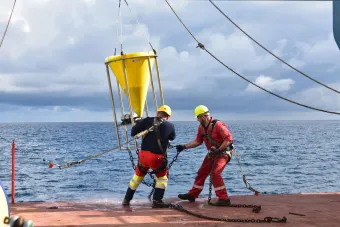
- New research led by the National Oceanography Centre (NOC) has shown a significant time difference in the rate of particles sinking to the bottom of the ocean, and why this occurs.
- The study, published in Frontiers in Earth Science used data gathered at the NOC-coordinated Porcupine Abyssal Plain Sustained Observatory (PAP-SO).
- The research provides an essential foundation for future work into how the ocean can be used to combat climate change.
Scientists from the National Oceanography Centre (NOC) have published new research showing a significant time difference in the rate of particles sinking to the bottom of the ocean and the reasons why this occurs. The research provides an essential foundation for future work into how the ocean can be used to combat climate change.
The data was gathered at the Porcupine Abyssal Plain Sustained Observatory (PAP-SO) in the Northeast Atlantic. A number of instruments are deployed at PAP-SO which record the changing characteristics of this environment. Located about 300 miles southwest of Ireland in a water depth of nearly 5000m, it has been gathering data since 1989 and continues to this day. PAP-SO monitors the long-term changes in the ocean environment, including atmosphere, weather, and the deep-ocean interior and seabed up to three miles below the ocean surface.
The project discovered that the structure of the ecosystem in the upper ocean plays a crucial role in determining how fast carbon is sequestered and why this changes over time. The upper ocean is considered to be around the first 100 meters of the ocean where small particles form naturally before gravity sinks them to the deep ocean in a process known as particle flux. Previously it had been thought that sequestration simply depended on the rate at which the microscopic plants grow, however, this new paper shows that the makeup of the ocean ecosystem itself has a significantly outsized impact.
Professor Richard Lampitt, Senior Research Scientist at the National Oceanography Centre, and lead author on the report, said: “This research shows the importance of ongoing ocean research. PAP-SO is currently one of only four such long-term projects in the world and understanding the reasons why particle flux varies so much is crucial as we seek to understand the way it functions and develop ways to mitigate the effects of climate change in the future.”
In the past few decades, the ocean has slowed down the rate of climate change by absorbing about 30% of all carbon emissions produced by humans. The process, named the Biological Carbon Pump (BCP) involves microscopic organisms from the upper ocean sinking to the deep ocean, sometimes thousands of meters below the surface. These organisms contain carbon which is removed from the atmosphere as CO2 and when they sink into the deep ocean, the carbon is removed from the atmosphere for hundreds or even thousands of years. The BCP is vital for the health of the planet as it currently transfers about 10 gigatonnes of carbon into the deep ocean every year that would otherwise end up in the atmosphere.
A specially designed buoy with numerous sensors has been deployed at a depth of 3000m as part of the PAP-SO project. There, traps collect sinking material into bottles every two weeks. Every year, the traps are recovered, and the samples removed before being replaced for the next year. Samples from the bottles are analysed at the NOC. This allows scientists to confidently compare each year and detect changes, trends and safely inform policy makers.